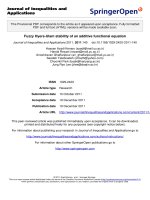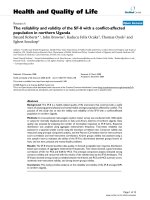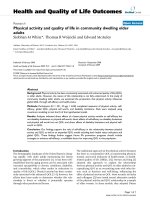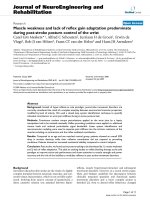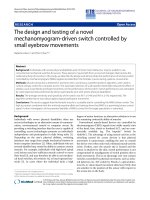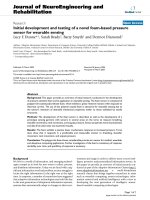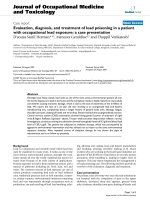Báo cáo hóa học: "One-Dimensional Nanostructures and Devices of II–V Group Semiconductors" ppt
Bạn đang xem bản rút gọn của tài liệu. Xem và tải ngay bản đầy đủ của tài liệu tại đây (793.29 KB, 10 trang )
NANO REVIEW
One-Dimensional Nanostructures and Devices of II–V Group
Semiconductors
Guozhen Shen Æ Di Chen
Received: 12 April 2009 / Accepted: 24 April 2009 / Published online: 15 May 2009
Ó to the authors 2009
Abstract The II–V group semiconductors, with narrow
band gaps, are important materials with many applications in
infrared detectors, lasers, solar cells, ultrasonic multipliers,
and Hall generators. Since the first report on trumpet-like
Zn
3
P
2
nanowires, one-dimensional (1-D) nanostructures of
II–V group semiconductors have attracted great research
attention recently because these special 1-D nanostructures
may find applications in fabricating new electronic and
optoelectronic nanoscale devices. This article covers the 1-D
II–V semiconducting nanostructures that have been syn-
thesized till now, focusing on nanotubes, nanowires, nano-
belts, and special nanostructures like heterostructured
nanowires. Novel electronic and optoelectronic devices
built on 1-D II–V semiconducting nanostructures will also
be discussed, which include metal–insulator-semiconductor
field-effect transistors, metal-semiconductor field-effect tran-
sistors, and p–n heterojunction photodiode. We intent to
provide the readers a brief account of these exciting research
activities.
Keywords Nanowires Á Nanotubes Á Nanobelts Á
Semiconductors Á Nanoelectronics
Introduction
Because of the ability to synthesize them in numerous
configurations and their unique physical, chemical, optical,
electrical, and magnetic properties, one-dimensional (1-D)
nanostructures have attracted great interest in recent years
[1–5]. 1-D nanostructures play important roles both as
interconnect and functional units in fabricating nanoscale
electronic, optoelectronic, electrochemical, and electro-
mechanical devices. 1-D nanostructures have been syn-
thesized for a lot of materials, including metals, II–VI and
III–V semiconductors, sulfides, nitrides, etc., using a vari-
ety of synthetic techniques, such as solution process,
vapor–solid process, vapor–liquid–solid process, template-
directed process and so on [6–40].
Semiconducting II–V compounds are important narrow
band gap semiconductors with great scientific and tech-
nological importance [41]. They are suggested to exhibit
pronounced size quantization effects due to the large
excitonic radii. Bulk II–V semiconductors have been used
as infrared detectors, lasers, solar cells, ultrasonic multi-
pliers, and Hall generators [42–50]. However, research on
nanoscale II–V semiconductors, especially 1-D nano-
structures, has been lingering far behind compared with
the significant progress in the studies of 1-D II–VI and
III–V semiconductors, mainly due to the significant syn-
thetic experimental difficulties, such as lack of general-
ized synthetic methodologies, instability in air, etc. Since
the first successfully synthesized trumpet-like Zn
3
P
2
nanowires in 2006, many kinds of interesting 1-D II–V
semiconductors nanostructures have been reported using
different techniques, which greatly promote their further
application in nanoscale electronic and optoelectronic
devices.
This article will provide a comprehensive review of the
state-of-the-art research activities focused on synthesis
and devices of 1-D II–V semiconducting nanostructures.
The first section introduces typical 1-D nanostructures
obtained on II–V semiconductors, including nanotubes,
G. Shen (&) Á D. Chen
Wuhan National Laboratory for Optoelectronics and College
of Optoelectronic Science and Technology, Huazhong
University of Science and Technology, Wuhan 430074,
People’s Republic of China
e-mail: ;
123
Nanoscale Res Lett (2009) 4:779–788
DOI 10.1007/s11671-009-9338-2
nanowires, nanobelts, and some special nanostructures.
Next, some important electronic and optoelectronic devi-
ces built on 1-D II–V semiconducting nanostructures are
presented, which include metal–insulator-semiconductor
field-effect transistors (MIS-FET), metal-semiconductor
field-effect transistors (MS-FET), and p–n heterojunction
photodiode. This review will then conclude with some
personal perspectives and outlook on the future develop-
ments in the 1-D II–V semiconducting nanostructures
research area.
Typical 1-D Nanostructures of II–V Group
Semiconductors
Since the first successfully synthesized trumpet-like Zn
3
P
2
nanowires in 2006, many kinds of interesting 1-D II–V
semiconducting nanostructures, such as nanotubes, nano-
wires, and nanobelts, special nanostructures have been
reported using different techniques. In this section, we will
discuss several typical 1-D nanostructures obtained on II–V
semiconductors.
Nanotubes
Considerable attention has been paid on semiconducting
nanotubes since the first report of carbon nanotubes by
Iijima in 1991 [11]. Nanotubes are often obtained for
materials with layered or pseudolayered structures [13].
Without these kinds of structures, templates (hard tem-
plates or soft templates) are usually used to promote the
formation of tubular structures [21, 51]. Recently, we
developed an in situ nanorod template method to synthe-
size high-quality single crystalline II–V nanotubes,
including Zn
3
P
2
nanotubes and Cd
3
P
2
nanotubes [52]. The
whole process can be expressed as shown in Fig. 1.This
process was performed in a vertical induction furnace at
high temperature and the mixture of ZnS (or CdS), Mn
3
P
2
and P powders were used as the evaporation sources. At
high reaction temperature, ZnS or CdS was evaporated and
reacted with graphite to generate Zn or Cd vapors, which
were transferred to low temperature region and deposited
on the surface of graphite crucible, resulted in the forma-
tion of Zn or Cd nanorods due to the anisotropic nature of
wurtzite Zn or Cd phases. At the same time, Mn
3
P
2
was
thermally decomposed to generate P gases. These newly
generated P gases deposited on the surface of Zn or Cd
nanorods and reacted with them to generate the Zn
3
P
2
or
Cd
3
P
2
shells. After a reaction time, the inner Zn or Cd
nanorods were consumed and finally only Zn
3
P
2
or Cd
3
P
2
nanotubes were formed.
Figure 2a is a SEM image of the Cd
3
P
2
product obtained
in the in situ nanorod template process. 1-D nanostructures
can be found deposited on the graphite crucible on a large
scale. A magnified SEM image shown inset clearly reveals
that they are hollow nanotubes. Figure 2b and c show
typical TEM images of the obtained Cd
3
P
2
nanotubes. The
clear brightness contrast confirms that they are hollow
nanotubes. Typical nanotubes have diameters of about
100 nm and the wall thickness of several nanometers.
As-synthesized Cd
3
P
2
nanotubes are of single crystalline
nature with the preferred growth direction perpendicular to
the (101) planes as revealed in Fig. 2d. Similarly, the
Zn
3
P
2
products obtained in the in situ template process are
also single crystalline nanotubes as shown in Fig. 2e. We
should mention that defects existed in the as-synthesized
Cd
3
P
2
and Zn
3
P
2
nanotubes because of the release of built-
in strain.
Nanowires
Nanowire is one of the most common 1-D structure and
many kinds of materials can form into the nanowire
structures. Till now, Cd
3
P
2
,Zn
3
P
2
, and Cd
3
As
2
among the
II–V group semiconductors were found to be able to form
into the nanowire structures. Omari et al. [53] reported the
synthesis of single-crystalline Cd
3
As
2
nanowires by ther-
mal evaporation of Cd
3
As
2
powders at 750 °C. Figure 3ais
a SEM image of the Cd
3
As
2
nanowires. Studies found that
these Cd
3
As
2
nanowires are single crystals with the growth
directions along the (112) crystal planes. Omari et al. also
investigated the optical properties of these nanowires and
found that they have IR active direct type absorption
transitions at 0.11, 0.28, and 0.54 eV, which make it pos-
sible to use these nanowires as low cost optoelectronic
devices and photodetectors operating in the long wave-
length range.
Liu et al. [54] reported the synthesis of Zn
3
P
2
nanowires
by the reaction between Zn and InP powders at 850 °C.
These Zn
3
P
2
nanowires are also single crystals and have
typical diameters of about 100 nm and lengths of tens of
microns, as revealed in Fig. 3b. During this process, Au
Fig. 1 Schematic illustration showing the formation of II–V nano-
tubes via the in situ nanorod template method
780 Nanoscale Res Lett (2009) 4:779–788
123
was used as catalysts to direct the nanowire growth and it is
obviously a vapor–liquid–solid (VLS) process.
Nanobelts
We were able to synthesize high quality Zn
3
P
2
and Cd
3
P
2
nanobelts on a large scale using a method similar to the
synthesis of Zn
3
P
2
and Cd
3
P
2
nanotubes [55]. Zn
3
P
2
and
Cd
3
P
2
nanobelts were synthesized by using a mixture of
ZnS (or CdS) and Mn
3
P
2
powders as the evaporation
source. The reaction was performed at 1350 °C for about
1 h. Figure 4a is a SEM image of the synthesized Zn
3
P
2
nanobelts with rectangular cross-sections, which have
diameters of about 100–200 nm and thickness of 40 nm.
A TEM image of a single Cd
3
P
2
nanobelt is depicted in
Fig. 4b. The twisted structure confirms it is a nanobelt and
the thickness is about 70 nm. The microstructures of the
Cd
3
P
2
nanobelts were studied by HRTEM and SAED.
Figure 4c and d are the HRTEM images taken from the
surface and body of a Cd
3
P
2
nanobelt, respectively.
Fig. 2 a SEM image; b, c TEM
image; and d HRTEM image of
Cd
3
P
2
nanotubes. e SEM image
of Zn
3
P
2
nanotubes
Fig. 3 SEM images of:
a Cd
3
As
2
nanowires and
b Zn
3
P
2
nanowires
Nanoscale Res Lett (2009) 4:779–788 781
123
The clearly resolved lattice fringes perpendicular to and
along the longitudinal axis of the nanobelt are 0.71
and 0.87 nm, respectively, corresponding to the (101) and
(010) lattice planes of tetragonal Cd
3
P
2
phase. Studies
revealed that these Cd
3
P
2
nanobelts have the preferred growth
directions along the [010] crystallographic orientations. For
the synthesis of Zn
3
P
2
and Cd
3
P
2
nanobelts, no catalyst was
used, indicating that it was governed by the vapor–solid (VS)
mechanism. In fact, we found that Zn
3
P
2
and Cd
3
P
2
nanobelts
can also be synthesized via the VLS mechanism if suitable
catalysts, such as indium, were selected.
Special 1-D Nanostructures
Synthesis and assembly of 1-D nanostructures with special
morphologies, shapes, and compositions have attracted
great interests very recently because they may process
interesting physical and chemical properties associated
with their specific characteristics. They may also be used to
fabricate special electronic and optoelectronic devices
which cannot be fulfilled using simple 1-D nanostructures.
Wang et al. [56] recently succeeded in synthesizing three-
dimensional (3-D) branched tree-like Zn
3
P
2
nanostructures
as shown in Fig. 5. These 3-D Zn
3
P
2
nanostructures were
synthesized in a thermal-assisted pulse-laser-deposition
(PLD) system using Zn
3
P
2
/ZnO/Zn as the target. A top view
image shown in Fig. 5a demonstrated that these 3-D nano-
structures have a sixfold symmetry. The tree-like branched
shapes were confirmed by the side view SEM image
depicted in Fig. 5b. The constituent branches of the tree-like
structures were found to be as long as several tens of
micrometers, with the diameters lying in the range of ten to
several hundred nanometers. During this process, it was
found that nanobelts were formed once the branches grew
much longer as indicated in Fig. 5c. The composition of the
tree-like Zn
3
P
2
structures was checked using energy-dis-
persive spectrometry (EDS) and the results confirm they are
pure Zn
3
P
2
(Fig. 5d).
Fig. 4 a SEM image of Zn
3
P
2
nanobelts. b TEM image and c,
d HRTEM images of Cd
3
P
2
nanobelts
782 Nanoscale Res Lett (2009) 4:779–788
123
1-D bicrystalline nanostructures have received great
attention because of their peculiar structures and structure-
related properties. Several kinds of 1-D bicrystalline
nanostructures have been obtained for ZnS, InP, etc.
[57–62]. We synthesized bicrystalline Zn
3
P
2
and Cd
3
P
2
nanobelts via a VS process in the vertical induction furnace
system [63]. The source materials used are a mixture of Zn
(or Cd), ZnS (or CdS), GaP, and Mn
3
P
2
powders. Figure 6a
is a SEM image of the Zn
3
P
2
product, which clearly shows
that long and straight nanobelts are obtained on a large
scale. Each nanobelt has a uniform width of 100–200 nm
and length in the range of tens of micrometers. A high-
magnification SEM image shown in Fig. 6b clearly reveals
that these nanobelts are bicrystals with distinct grain
boundary along the direction parallel to the growth direc-
tion. TEM images of several typical Zn
3
P
2
bicrystal
nanobelts were depicted in Fig. 6c and d. Grain boundaries
were clearly observed in the middle of the nanobelts,
indicating the bicrystal nature. These Zn
3
P
2
bicrystal
nanobelts are composed of two single-crystal with the
Fig. 5 a–c SEM images and d
EDS spectrum of tree-like
branched Zn
3
P
2
nanostructures
Fig. 6 a, b SEM images; c, d
TEM images of bicrystal Zn
3
P
2
nanobelts. e HRTEM image and
f, g FFT patterns of bicrystal
Cd
3
P
2
nanobelts
Nanoscale Res Lett (2009) 4:779–788 783
123
preferred growth axis along the [101] directions. HRTEM
image taken from a single Cd
3
P
2
bicrystal nanobelt was
shown in Fig. 6e. The marked lattice fringes in each part of
the Cd
3
P
2
nanobelt are 0.71 nm, in accordance with the
(101) plane of tetragonal Cd
3
P
2
. The correspondence Fast
Fourier Transform (FFT) patterns taken from the two parts
within a single bicrystal nanobelt were demonstrated in
Fig. 6f and g, which verified the formation of bicrystalline
Cd
3
P
2
nanobelts with the preferred growth along the [101]
directions.
Besides the above discussed special 1-D II–V semi-
conducting nanostructures, we were also able to get other
kinds of interesting 1-D II–V semiconducting nanostruc-
tures. For instance, Fig. 7a and b show the SEM and TEM
image of zigzag twinned Zn
3
P
2
nanowires, which were also
obtained in the vapor phase process [64]. Spherical indium
Fig. 7 a SEM image and
b TEM image of zigzag twinned
Zn
3
P
2
nanowires. c, d TEM
image of zigzag single-crystal
Zn
3
P
2
nanowires. e–g Typical
SEM image of trumpet-like
Zn
3
P
2
nanowires
784 Nanoscale Res Lett (2009) 4:779–788
123
nanoparticles were found attached to the zigzag nanowires,
indicating that the process was governed by the VLS
mechanism. These zigzag Zn
3
P
2
nanowires typically have
periodic twins with a period of 50–120 nm along the whole
nanowires. Lots of defects were found in the twin bound-
aries area, similar to previous reports on twinned nanowires
[57–62]. If we did not use indium catalysts and kept other
conditions constant, we synthesized zigzag single crystal
Zn
3
P
2
nanowires as shown in Fig. 7c and d. The angle
between two neighboring kinks is about 120°, consistent
with that between the (001) and (101) planes of tetragonal
Zn
3
P
2
phase. Figure 7e–g are SEM images of trumpet-like
Zn
3
P
2
nanowires, which are composed of a hollow cone
supported by a nanowire [65]. The trumpet-like Zn
3
P
2
nanowires are single crystals with preferred growth direc-
tions along the [010] orientations. Other special II–V
semiconducting 1-D nanostructures include 1-D hierarchi-
cal Zn
3
P
2
/ZnS nanotube/nanowires heterostructures, which
consist of main Zn
3
P
2
nanotube wrapped with high density
ZnS nanowires [66].
We have discussed above several kinds of 1-D II–V
semiconducting nanostructures obtained till now. By
carefully controlling the experimental parameters, such as
evaporation sources, temperature, carrier gases, etc., more
1-D nanostructures are expected to be obtained for II–V
group semiconductors.
Device Applications of 1-D II–V Semiconducting
Nanostructures
As an important group of narrow band gap semiconductors,
1-D II–V semiconducting nanostructures can be used to
fabricate nanoscale electronic and optoelectronic devices.
Several kinds of nanodevices had been fabricated built on
single 1-D II–V semiconducting nanostructure, such as
MIS-FET, MS-FET, and p–n heterojunction photodiode.
MIS-FET Built on Single 1-D II–V Semiconducting
Nanostructures
Figure 8a inset is a schematic illustration of a MIS-FET
built on a single Zn
3
P
2
nanowire. Basically, the MIS-FET is
supported on an oxidized p-type silicon substrate with the
underlying conducting silicon as the back gate electrode to
vary the electrostatic potential of the nanostructure. Two
metal contacts, such as Au and Ti/Au, corresponding to the
source and drain electrodes, are defined by either photoli-
thography or electron beam lithography, followed by
evaporation of suitable metal contacts. The I
ds
–V
ds
curves
of the MIS-FET are illustrated in Fig. 8a, showing typical
p-type behavior of the Zn
3
P
2
nanowire. From the I
ds
–V
ds
measurement, the resistivity of the nanowire is calculated to
be about 1.96 Xcm. We also built MIS-FET using zigzag
Fig. 8 a I
ds
–V
ds
characteristics
of Zn
3
P
2
nanowire MIS-FET
under gate bias ranging from
-1 V to 7 V with a step of
0.5 V. The inset is a schematic
illustration of the device.
b I
ds
–V
ds
characteristics of
single zigzag Zn
3
P
2
nanowire-
based MIS-FET, showing
p-type behavior. I–V curves of
c Zn
3
P
2
and d Cd
3
P
2
nanobelts
measured at 300–100 K. The
insets show the conductance in a
logarithmic scale at zero bias
voltage plotted as a function of
1000/T
Nanoscale Res Lett (2009) 4:779–788 785
123
Zn
3
P
2
nanowire as shown in Fig. 8b inset. As-fabricated
MIS-FET also confirms the p-type behavior of the zigzag
nanowire.
To investigate the electronic transport behaviors of 1-D
II–V semiconducting nanostructures, we fabricated MIS-
FET built on single Zn
3
P
2
and Cd
3
P
2
bicrystal nanobelts
and explored the electronic transport behaviors as a func-
tion of temperature in vacuum [63]. A SEM image of the
Zn
3
P
2
MIS-FET is depicted in Fig. 8c inset. Figure 8c
displays the I–V curves of a Zn
3
P
2
bicrystal nanobelt
MIS-FET device measured in the temperature region of
100–300 K without applying gate voltage. The conduc-
tance of the device continuously decreased as the temper-
ature decreased. The zero-bias conductance at 300 K is
calculated to be 27.75 nano-Siemens (nS) and it decreases
to 0.01 nS at 100 K. Plotted the zero-bias conductance in a
logarithmic scale as a function of 1000/T gives a linear
behavior within the temperature region investigated. All
these results suggested that the thermal activation of car-
riers is the dominant transport mechanism for the Zn
3
P
2
bicrystal nanobelt MIS-FET. The electronic transport
behavior of Cd
3
P
2
bicrystal nanobelts was also investigated
at different temperatures and the results (Fig. 8d) also
suggested a dominant thermal activation of carriers trans-
port mechanism.
MS-FET Built on Single 1-D II–V Semiconducting
Nanostructures
Liu et al. [67] fabricated MS-FET using single Zn
3
P
2
nanowire as the active material. Basic structure of the
MS-FET is demonstrated in Fig. 9a, in which Ni/Au was
used as electrodes and Al as the top gate electrode across
the nanowire. The typical I
SD
–V
SD
characteristics of a
p-type Zn
3
P
2
nanowire based MS-FET measured at room
temperature under gate biases ranging from -0.5 to 0 V
with a step of 0.1 V is depicted in Fig. 9b. As-fabricated
MS-FET shows p-type conductance behavior and it is
turned off at zero gate bias, indicating that the MS-FET
was in the E-mode.
p–n Heterojunction Photodiode Built with Zn
3
P
2
Nanowires and ZnO Nanowires
Very recently, Wang et al. fabricated p–n heterojunction
photodiode using a crossed heterojunction made of p-type
Zn
3
P
2
nanowire and n-type ZnO nanowire [56]. The device
structure is displayed in Fig. 10a inset and the I–V curve at
reverse and forward bias is illustrated in Fig. 10. Wang
et al. studied the device behaviors by checking the photo-
diode under reverse bias and in the dark and under the
illumination of light with wavelength of 532 or 680 nm.
The results are presented in Fig. 10b, which show apparent
current enhancement by the light. The increase of the
current results from the generation of electron-hole pairs
inside the depletion region and nearby under the excitation
Fig. 9 a Schematic illustration of a Zn
3
P
2
nanowire based MS-FET.
b I
SD
–V
SD
characteristics of a p-type Zn
3
P
2
nanowire based MS-FET
measured at room temperature under gate biases ranging from -0.5 to
0 V with a step of 0.1 V
Fig. 10 a I–V curve for ZnO/Zn
3
P
2
nanoscale heterojunction at
reverse and forward bias. Inset shows the prototype of the nanodevice.
b I–V curve of ZnO/Zn
3
P
2
heterojunction under illumination of
different wavelengths as displayed in logarithmic scale under reverse
bias
786 Nanoscale Res Lett (2009) 4:779–788
123
of the light. The p–n heterojunction photodiode gives rapid
response and very high on/off ratio upon light illumination.
Conclusion
In conclusion, we provide a comprehensive review of the
state-of-the-art research activities focused on the synthesis
and device applications of 1-D II–V semiconducting
nanostructures. The rapid expended achievements, till now,
toward 1-D II–V semiconducting nanostructures should
inspire more and more research efforts to address the
remaining challenges in this interesting filed.
Although comprehensive efforts have been made toward
the synthesis of high-quality 1-D II–V semiconducting
nanostructures, there is still plenty of room left unex-
ploited. We believe that future work should continue to
focus on generating them in more controlled, predictable,
and simple ways. The II–V semiconductors exhibit pro-
nounced size quantization effects due to the large excitonic
radii, thus, it is important to synthesize 1-D II–V semi-
conducting nanostructures with diameters smaller than the
excitonic radii. For example, one needs to find ways to get
II–V semiconducting nanotubes with either very small
diameter or very thin wall thickness. The physical and
chemical properties of II–V semiconducting nanostructures
with diameters smaller than the excitonic radii will then
need to be investigated and more interesting results are
expected to be gotten soon.
Besides, more functional nanoscale electronic and
optoelectronic devices are expected to be built on 1-D II–V
semiconducting nanostructures and the performance of the
devices will be largely improved with the progress of
producing high-quality 1-D II–V semiconducting
nanostructures.
Acknowledgment The authors acknowledge financial support from
the High-level Talent Recruitment Foundation of Huazhong Univer-
sity of Science and Technology. The authors acknowledge the per-
mission from the corresponding publishers/groups to reproduce their
materials, especially figures, used in this paper.
References
1. J. Hu, T.W. Odom, C.M. Lieber, Acc. Chem. Res. 32, 435 (1999).
doi:10.1021/ar9700365
2. Y. Cui, C.M. Lieber, Science 291, 851 (2001). doi:10.1126/
science.291.5505.851
3. G.Z. Shen, Y. Bando, D. Golberg, Int. J. Nanotechnol. 4, 730
(2007)
4. Y. Xia, P. Yang, Y. Sun, Y. Wu, B. Mayer, B. Gates, Y. Yin,
F. Kim, H. Yan, Adv. Mater. 15, 353 (2003). doi:10.1002/adma.
200390087
5. Z.W. Pan, Z.R. Dai, Z.L. Wang, Science 291, 1947 (2001). doi:
10.1126/science.1058120
6. Y. Huang, X. Duan, Q. Wei, C.M. Lieber, Nature 291, 630 (2001)
7. S.Y. Bae, H. Seo, J. Park, H. Yang, J.C. Park, S.Y. Lee, Appl.
Phys. Lett. 81, 126 (2002). doi:10.1063/1.1490395
8. H.T. Ng, J. Li, M.K. Smith, P. Nguyen, A. Cassel, J. Han,
M. Meyyappan, Science 300, 1249 (2003). doi:10.1126/science.
1082542
9. W. Lu, Y. Ding, Y. Chen, Z.L. Wang, J. Fang, J. Am. Chem. Soc.
127, 10112 (2005). doi:10.1021/ja052286j
10. C.B. Murray, D.J. Norris, M.G. Bawendi, J. Am. Chem. Soc. 115,
8706 (1993). doi:10.1021/ja00072a025
11. S. Iijima, Nature 354, 56 (1991). doi:10.1038/354056a0
12. C.R. Martin, Science 266, 1961 (1994). doi:10.1126/science.266.
5193.1961
13. Y. Feldman, E. Wasserman, D.J. Srolovitz, R. Tenne, Science
267, 222 (1995). doi:10.1126/science.267.5195.222
14. D. Wang, H.J. Dai, Angew. Chem. Int. Ed. Engl. 41, 4783 (2002).
doi:10.1002/anie.200290047
15. J. Golberger, R. He, Y. Zhang, S. Lee, H. Yan, H. Choi, P. Yang,
Nature 422, 599 (2003). doi:10.1038/nature01551
16. B. Gates, Y. Yin, Y. Xia, J. Am. Chem. Soc. 122, 12582 (2000).
doi:10.1021/ja002608d
17. X. Wang, Y.D. Li, Angew. Chem. Int. Ed. Engl. 41, 4790 (2002).
doi:10.1002/anie.200290049
18. J.K. Yuan, W. Li, S. Gomez, S.L. Suib, J. Am. Chem. Soc. 127,
14184 (2005). doi:10.1021/ja053463j
19. B. Liu, H.C. Zeng, J. Am. Chem. Soc. 125, 4430 (2003). doi:
10.1021/ja0299452
20. G.R. Patzke, F. Krumeich, R. Nesper, Angew. Chem. Int. Ed.
Engl. 41, 2446 (2003). doi:10.1002/1521-3773(20020715)41:
14\2446::AID-ANIE2446[3.0.CO;2-K
21. H.J. Fan, M. Knez, R. Scholz, K. Nielsch, E. Pippel, D. Hesse,
M. Zacharias, U. Gosele, Nat. Mater.
5, 627 (2006). doi:10.1038/
nmat1673
22. S. Han, C. Li, Z. Liu, B. Lei, D. Zhang, W. Jin, X. Liu, T. Tang,
C. Zhou, Nano Lett. 4, 1241 (2004). doi:10.1021/nl049467o
23. M. Nath, C.N.R. Rao, J. Am. Chem. Soc. 123, 4841 (2001). doi:
10.1021/ja010388d
24. G.Z. Shen, J. Cho, J. Yoo, G. Yi, C.J. Lee, J. Phys. Chem. B 109,
9294 (2005). doi:10.1021/jp044888f
25. G.Z. Shen, Y. Bando, D. Golberg, Appl. Phys. Lett. 88, 123107
(2006). doi:10.1063/1.2186980
26. G.Z. Shen, Y. Bando, D. Chen, B. Liu, C. Zhi, D. Golberg, J.
Phys. Chem. B 110, 3973 (2006). doi:10.1021/jp056783y
27. G.Z. Shen, Y. Bando, B. Liu, C. Tang, Q. Huang, D. Golberg,
Chem. Eur. J. 12, 2987 (2006). doi:10.1002/chem.200500937
28. G.Z. Shen, Y. Bando, C. Ye, B. Liu, D. Golberg, Nanotechnology
17, 3468 (2006). doi:10.1088/0957-4484/17/14/019
29. G.Z. Shen, Y. Bando, B. Liu, D. Golberg, C.J. Lee, Adv. Funct.
Mater. 16, 410 (2006). doi:10.1002/adfm.200500571
30. G.Z. Shen, D. Chen, C.J. Lee, J. Phys. Chem. B 110, 15689
(2006). doi:10.1021/jp0630119
31. G.Z. Shen, D. Chen, J. Am. Chem. Soc. 128, 11762 (2006)
32. G.Z. Shen, Y. Bando, J. Hu, D. Golberg, Appl. Phys. Lett. 90,
123101 (2007). doi:10.1063/1.2716242
33. G.Z. Shen, D. Chen, C. Zhou, Chem. Mater. 20, 3788 (2008). doi:
10.1021/cm8008557
34. G.Z. Shen, P.C. Chen, Y. Bando, D. Golberg, C. Zhou, Chem.
Mater. 20, 6779 (2008). doi:10.1021/cm802042k
35. G.Z. Shen, P.C. Chen, C. Zhou, J. Mater. Chem. 19, 828 (2009).
doi:10.1039/b816543b
36. A. Javey, J. Guo, Q. Wang, M. Lundstrom, H. Dai, Nature 424,
654 (2003). doi:10.1038/nature01797
37. Z.L. Wang, Adv. Mater. 15, 432 (2003). doi:10.1002/adma.
200390100
38. J. Jung, H. Kobayashi, K.J.C. Van Bommel, S. Shinkai, T. Shimizu,
Chem. Mater. 14, 1445 (2002). doi:10.1021/cm011625e
Nanoscale Res Lett (2009) 4:779–788 787
123
39. F. Dumestre, B. Chaudret, C. Amiens, M. Respaud, P. Fejes,
P. Renaud, P. Zurcher, Angew. Chem. Int. Ed. Engl. 42, 5213
(2003). doi:10.1002/anie.200352090
40. L. Samuelson, Mater. Today 6, 22 (2003). doi:10.1016/
S1369-7021(03)01026-5
41. O. Madelung, Data in science and technology: semiconductors
other than group IV elements and III–V compounds (Springer,
Berlin, Germany, 1991)
42. W. Zdanowicz, L. Zdanowicz, Annu. Rev. Mater. Sci. 5, 301
(1975). doi:10.1146/annurev.ms.05.080175.001505
43. E.K. Arushanov, Prog. Crystallogr. Growth Charact. 3, 211
(1980). doi:10.1016/0146-3535(80)90020-9
44. V.B. Lazarev, V.Y. Schevchenko, Y.H. Greenberg, V.V. Sobo-
lein, II–V semiconducting compounds (Nauka, Moscow, Russia,
1978)
45. M. Bushan, A. Catalano, Appl. Phys. Lett. 38, 39 (1981). doi:
10.1063/1.92124
46. J.M. Pawlikowski, Infrared Phys. 29, 177 (1988). doi:10.1016/
0020-0891(88)90007-3
47. M.P. Bichat, J.L. Pascal, F. Gillot, F. Favier, Chem. Mater. 17,
6761 (2005). doi:10.1021/cm0513379
48. E.A. Fagen, J. Appl. Phys. 50, 6505 (1979). doi:10.1063/1.325
746
49. W.E. Buhro, Polyhedron 13, 1131 (1994). doi:10.1016/S0277-
5387(00)80250-8
50. M. Green, P. O’Brien, Chem. Mater. 13, 4500 (2001). doi:
10.1021/cm011009i
51. C. Yan, J. Liu, F. Liu, J. Wu, K. Gao, D.F. Xue, Nanoscale Res.
Lett. 3, 473 (2008). doi:10.1007/s11671-008-9193-6
52. G.Z. Shen, Y. Bando, C. Ye, X. Yuan, T. Sekiguchi, D. Golberg,
Angew. Chem. Int. Ed. Engl. 45, 7568 (2006). doi:10.1002/
anie.200602636
53. M. Omari, N. Kouklin, G. Lu, J. Chen, M. Gajdardziska-Josi-
fovska, Nanotechnology 19, 105301 (2008). doi:10.1088/
0957-4484/19/10/105301
54. C. Liu, L. Dai, L.P. You, W.J. Xu, R.M. Ma, W.Q. Yang,
Y.F. Zhang, G.G. Qin, J. Mater. Chem. 18, 3912 (2008). doi:
10.1039/b809245a
55. G.Z. Shen, Y. Bando, D. Golberg, J. Phys. Chem. C 111, 5044
(2007). doi:10.1021/jp068792s
56. R. Yang, Y.L. Chueh, J.R. Morber, R. Snyder, L.J. Chou,
Z.L. Wang, Nano Lett. 7, 269 (2007). doi:10.1021/nl062228b
57. C. Xu, S. Youkey, J. Wu, J. Jiao, J. Phys. Chem. C 111, 12490
(2007). doi:10.1021/jp0730794
58. J. Jie, W. Zhang, Y. Jiang, X. Meng, J.A. Zapien, M. Shao,
S.T. Lee, Nanotechnology 17, 2913 (2007). doi:10.1088/0957-
4484/17/12/015
59. G.Z. Shen, Y. Bando, B. Liu, C. Tang, D. Golberg, J. Phys.
Chem. B 110, 20129 (2006). doi:10.1021/jp057312e
60. H.W. Kim, S.H. Shim, Thin Solid Films 515, 5158 (2007). doi:
10.1016/j.tsf.2006.10.043
61. X. Tao, X.D. Li, Nano Lett. 8, 505 (2008). doi:10.1021/nl072678j
62. K. Zou, X. Qi, X. Duan, S. Zhou, X. Zhang, Appl. Phys. Lett. 86,
013103 (2005). doi:10.1063/1.1844041
63. G.Z. Shen, P.C. Chen, Y. Bando, D. Golberg, C. Zhou, Chem.
Mater. 20, 7319 (2008). doi:10.1021/cm802516u
64. G.Z. Shen, P.C. Chen, Y. Bando, D. Golberg, C. Zhou, J. Phys.
Chem. C 112, 16405 (2008). doi:10.1021/jp806334k
65. G.Z. Shen, Y. Bando, J.Q. Hu, D. Golberg, Appl. Phys. Lett. 88,
143105 (2006). doi:10.1063/1.2192090
66. G.Z. Shen, C. Ye, D. Golberg, J. Hu, Y. Bando, Appl. Phys. Lett.
90, 073115 (2007). doi:10.1063/1.2539821
67. C. Liu, L. Dai, R.M. Ma, W.Q. Yang, G.G. Qin, J. Appl. Phys.
104, 034302 (2008). doi:10.1063/1.2960494
788 Nanoscale Res Lett (2009) 4:779–788
123
